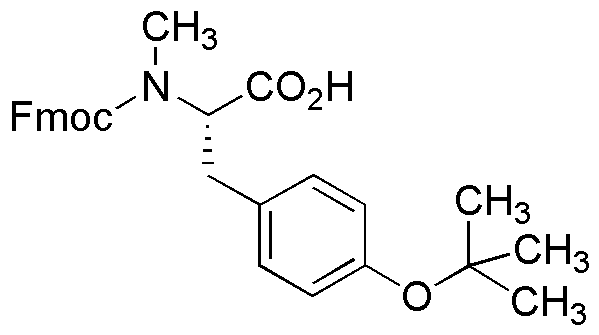|
Fmoc-N-methyl-O-tert-butyl-L-tyrosine is widely utilized in research focused on:
- Peptide Synthesis: This compound is a key building block in the synthesis of peptides, particularly in solid-phase peptide synthesis (SPPS). Its protective groups allow for selective reactions, facilitating the creation of complex peptide structures.
- Drug Development: In pharmaceutical research, it is used to develop peptide-based drugs. Its stability and compatibility with various reaction conditions make it an ideal candidate for creating therapeutic peptides.
- Bioconjugation: The compound can be employed in bioconjugation processes, where it helps attach peptides to other biomolecules, enhancing drug delivery systems and improving the efficacy of therapeutic agents.
- Research in Neuroscience: It plays a role in synthesizing neuropeptides, which are crucial for studying neurological functions and disorders, providing insights into potential treatments for conditions like depression and anxiety.
- Custom Peptide Libraries: Researchers utilize it to create diverse peptide libraries for screening and identifying new bioactive compounds, aiding in the discovery of novel therapeutics.
General Information
Properties
Safety and Regulations
Applications
Fmoc-N-methyl-O-tert-butyl-L-tyrosine is widely utilized in research focused on:
- Peptide Synthesis: This compound is a key building block in the synthesis of peptides, particularly in solid-phase peptide synthesis (SPPS). Its protective groups allow for selective reactions, facilitating the creation of complex peptide structures.
- Drug Development: In pharmaceutical research, it is used to develop peptide-based drugs. Its stability and compatibility with various reaction conditions make it an ideal candidate for creating therapeutic peptides.
- Bioconjugation: The compound can be employed in bioconjugation processes, where it helps attach peptides to other biomolecules, enhancing drug delivery systems and improving the efficacy of therapeutic agents.
- Research in Neuroscience: It plays a role in synthesizing neuropeptides, which are crucial for studying neurological functions and disorders, providing insights into potential treatments for conditions like depression and anxiety.
- Custom Peptide Libraries: Researchers utilize it to create diverse peptide libraries for screening and identifying new bioactive compounds, aiding in the discovery of novel therapeutics.
Documents
Safety Data Sheets (SDS)
The SDS provides comprehensive safety information on handling, storage, and disposal of the product.
Product Specification (PS)
The PS provides a comprehensive breakdown of the product’s properties, including chemical composition, physical state, purity, and storage requirements. It also details acceptable quality ranges and the product's intended applications.
Certificates of Analysis (COA)
Search for Certificates of Analysis (COA) by entering the products Lot Number. Lot and Batch Numbers can be found on a product’s label following the words ‘Lot’ or ‘Batch’.
Número de catálogo
Número de lote/lote
Certificates Of Origin (COO)
This COO confirms the country where the product was manufactured, and also details the materials and components used in it and whether it is derived from natural, synthetic, or other specific sources. This certificate may be required for customs, trade, and regulatory compliance.
Número de catálogo
Número de lote/lote
Safety Data Sheets (SDS)
The SDS provides comprehensive safety information on handling, storage, and disposal of the product.
DownloadProduct Specification (PS)
The PS provides a comprehensive breakdown of the product’s properties, including chemical composition, physical state, purity, and storage requirements. It also details acceptable quality ranges and the product's intended applications.
DownloadCertificates of Analysis (COA)
Search for Certificates of Analysis (COA) by entering the products Lot Number. Lot and Batch Numbers can be found on a product’s label following the words ‘Lot’ or ‘Batch’.
Número de catálogo
Número de lote/lote
Certificates Of Origin (COO)
This COO confirms the country where the product was manufactured, and also details the materials and components used in it and whether it is derived from natural, synthetic, or other specific sources. This certificate may be required for customs, trade, and regulatory compliance.


